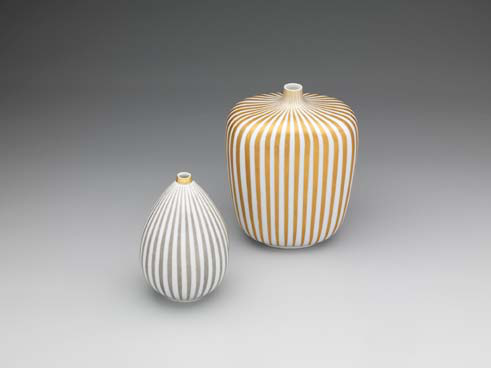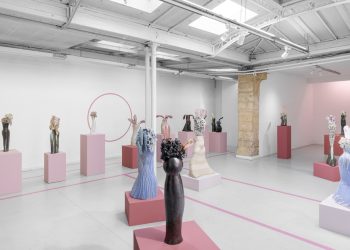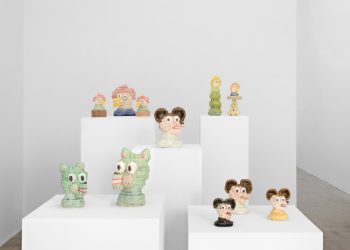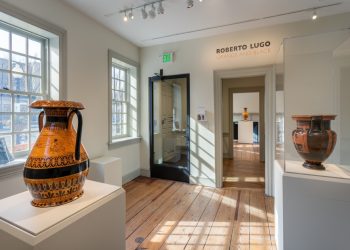
Langenthal retrospective / Musée Ariana, Geneva, Switzerland
May 23 – November 25, 2012
Opening reception: Wednesday, May 22 at 6.30 pm.
#1
The Langenthal porcelain manufactory. From industrial design to Sunday china
The fascinating history of the only 20th century Swiss porcelain factory began in 1906 in the Bernese town of Langenthal. Deeply rooted in the Swiss identity, the porcelain manufactory Langenthal SA – affectionately known by its workers as the “Porzi” – became noted for its cutting-edge technology, the diversity of its products as well as the quality of its porcelain. The artistic output followed the dominant aesthetic currents of the century while still preserving its local character. From Art Nouveau and Art Deco to the deliciously “vintage” designs of the 1950s and 1960s, from pseudo-rustic to avant-garde propositions, from collaborations with artists and designers to the influence of the artistic directors of the manufactory, the history of Langenthal is closely linked to the evolution of taste.
This collaboration with the Langenthal manufactory has been an opportunity to update the rich archives : hand-painted design books, catalogues of forms and motifs, publicity leaflets and brochures, archive photos. Loans from public and private institutions enrich and complete the important collection of the Musée Ariana (over 1000 pieces). All the conditions have been met to allow a portrait to be drawn of 20th century industrial porcelain in Switzerland.
The History of A Courageous Project
When some notables of the Bernese town of Langenthal decided to found a porcelain manufactory in July 1906, they were armed with a good dose of courage and staunch enthusiasm. Indeed, after a century without any porcelain manufacture in Switzerland, there were no raw materials and, more particularly, no specialized local workforce available. They had to start completely from scratch in order to rewrite Switzerland into the porcelain history books.
After a chaotic start, production became more organized and the manufactory began displaying its goods in specialized exhibitions and fairs with encouraging success. The outbreak of the First World War curbed this momentum. In 1937, in order to reduce its dependence on imported coal, the manufactory constructed the first 24-hour electric tunnel kiln. This technological breakthrough allowed the company to increase and diversify its production.
After the Second World War, the manufactory enjoyed a heyday. The remarkable quality of the Swiss-made products enabled it to fight off the competitors. In 1964, the firm recorded the highest number of employees in its history, with 950 workers.
From the 1980s onwards, despite its modernisation efforts, the manufactory struggled to withstand the fierce competition within the sector and developments in tableware. The company was bought out successively by Keramik Holding Laufen AG and then by the Czech group, G. Benedikt. Today, although its name still survives, all Langenthal porcelain is manufactured in Karlovy Vary (Carlsbad) in the Czech Republic.
LANGENTHAL, A History of Style
The first years of the manufactory were marked by Heimatstil (Domestic Revival) ornamentation, produced by the painter Rudolf Münger, its artistic advisor. With its floral patterns and garlands and figures of soldiers or people in traditional costumes, this nationalistic style corresponded to the company’s desire to offer products in tune with local taste.
It was with the arrival of Fernand Renfer at the manufactory (he took up the post of artistic director in 1920) that the company embarked on the path of modernity. The flowers on brightly-coloured grounds, reminiscent of Art Nouveau, were replaced by more stylized Art Deco ornamentation, that left much of the immaculate white porcelain apparent. This inter-war period was one of the most brilliant for the production and pieces from that time are much sought after by collectors today. Since 1925, Langenthal has been part of the Swiss work federation, the Werkbund, a movement that aims to combine aesthetic concerns and industrial production by fitting the form to the function.
1956 saw the opening of an artistic studio for forms and decoration, directed by Fernand Renfer and assisted by his son, Pierre. In addition to the creation of original and innovative designs for tableware, the studio developed a high quality artistic section : flambé enamels, pâte-sur-pâte decoration produced by slip painting on porcelain tinted celadon green, as well as surfaces animated with striations or dots that are either painted or in relief.
The studio was also the centre for artistic collaborations with external designers, painters and sculptors. In 1993, in order to revive the market and to adapt to developments in tableware, the company launched the concept Bopla! The principle is a simple one : to produce annual series based on simple forms with brightly-coloured printed motifs by famous designers. The principle of the collection adapted to tableware makes it possible to create composite and evolving series.
Today, the range of products offered by the manufactory and made in the Czech Republic is mainly targeted at hotels and restaurants and responds to the contemporary taste for stylised forms and minimalist designs.

#2
Langenthal revisited
Within the context of the exhibition devoted to the Langenthal porcelain manufactory, the Musée Ariana has invited five ceramists to offer their uninhibited artistic vision of this company, through a piece of work created specially for the occasion : Müller-B, Margareta Daepp, Magdalena Gerber, Michèle Rochat and Paul Scott.
In 1990, the Zurich ceramist Müller-B (1953-) spent a month at the Bernese manufactory. During her stay, she took the traditional forms produced there, in particular the coffee pots, which now belong to a past era (the development of coffee-making machines has rendered this utensil obsolete), in order to reinterpret them and to produce an installation entitled “Heisser Kaffee” (Hot Coffee). The artist will propose a larger-scale vision of this conceptual work.
It is also the form of the coffee pot, in this case, the elegant Landi mocha coffee maker of the 1940s, that Margareta Daepp (1959-) has taken as a basis for her work. Here, the container has disappeared and from this gesture belonging to the past only the content remains, the aromatic coffee that pours in a perfect trajectory from the spout of the pot to fill the cup. The content has become object and everything surrounding it – the social ritual of drinking coffee inpleasant company, just like the Langenthal porcelain – seems to have evaporated.
With “Dschinn”, Magdalena Gerber (1966-), questions in a politico-poetic manner the disappearance of artistic and traditional savoir-faire in Swiss porcelain production. Totemic piles of Langenthal chinaware are covered with a froth of bone china porcelain, which softens the contours of the pieces, recalling the cargoes of Chinese porcelain lost at sea. Oscillating between beauty and ugliness, “Dschinn” associates industrial rigor and random form in sculptures from which a transparent cloud escapes – the spirit of a bottle.
Michèle Rochat (1971-) has worked for several years on ceramic decoration, attempting by different means to bring to light daily objects by taking a fresh look at them. Here, she adapts as her starting point a decorative frieze from a Langenthal service, which she disproportionately enlarges before reproducing it on a set of plates. Each piece bears a random decorative fragment that only makes sense when the whole series is juxtaposed.
The British artist, Paul Scott (1953-) is the only foreign ceramist in the group. For the Musée Ariana, he has recycled plates from a blue and white Langenthal service found at the flea market in Geneva. Onto these, using a transfer-printing process, he has transposed landscapes comprising the four Swiss nuclear power stations : Beznau, Gösgen, Mühleberg and Leibstadt, as well as elements taken from old engravings, in a critical and provocative juxtaposition that combines an idyllic vision of Switzerland and contemporary reality.
Hours: Thursday-Sunday, 10 am – 6 pm. Closed on Mondays.
Curators
Anne-Claire Schumacher, Curator
anne-claire.schumacher@ville-ge.ch
Ana Quintero Chatelanat, Research Assistant
ana.quintero-chatelanat@ville-ge.ch
Exhibition design
Roland Aeschlimann assisted by Jean-Marc Cherix
Cultural Interpretation
Hélène de Ryckel, Head of Cultural Interpretation
adp-ariana@ville-ge.ch
CONTACT
Christine Azconegui Suter
Head of Communication and Promotion
Tel +41 22 418 54 55
Fax +41 22 418 54 51
ariana@ville-ge.ch
Musée Ariana
Avenue de la Paix 10
1202 Geneva
Switzerland
www.ville-geneve.ch/ariana
Above (first): Vases, 1958, 1959. Printed striations in grey enamel and gold. Height 16.5 cm max. Collection Musée Ariana, Geneva. Photo by Mauro Magliani and Barbara Piovan.
Above (second): Margareta Daepp, 2012, Resin, Height 19 cm, Collection of the artist. Photo by Dominique Uldry, Berne.





















I am a porcelain artists in the United States. I have inherited a product called Incrustation or Satiné, Clair de lune- relief. Peintire sur porcelaine – Genéve Switzerland.
Can you please tell me the purpose of the product and it’s application? Your time is much appreciated.
Cay
CayPalmer@gmail.com